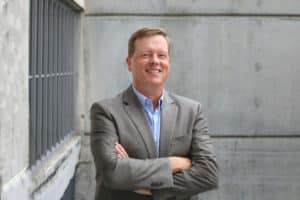TEED UP: T-Mobile Park in Seattle, site of the 2023 MLB All-Star Game, is among the stadiums that sports architects Paul Leskovac and Ed Hurtig have worked on over their respective careers. (Getty Images)
New hires boost experience at highest level of sports
KANSAS CITY, Missouri — Two sports architecture firms prominent in the design of college venues have expanded their respective practices to pursue a greater number of projects at the big league level.
HNTB and DLR Group have both strengthened their respective sports groups apart from the college space, hiring veteran designers whose portfolios cover NBA and NHL arenas and Major League Baseball stadiums.
In both cases, officials with HNTB and DLR Group say the strategy is driven in part by market demand for arena and stadium renovations, according to principals with the two companies.
Paul Leskovac and Brad Albers have joined HNTB over the past 11 months.
Leskovac, the most recent addition, was hired in May as design manager. Leskovac spent 11 years at HOK, where he worked on, among other projects, Little Caesars Arena, initial designs for a new Calgary Flames arena and ballpark renovations for the Chicago White Sox, Detroit Tigers and Seattle Mariners. Before that, at Populous, Leskovac served as lead project architect on Target Field.

Paul Leskovac
At HNTB, Leskovac rejoins former HOK and 360 Architecture colleagues Ryan Gedney and Emily (Fleming) Louchart, both brought on over the past five years, to form a nucleus of experienced arena designers whose work extends to reshaping State Farm Arena and developing Rogers Place, the Edmonton Oilers’ arena that opened in 2016.
Albers’ title at HNTB is sports managing director and associate vice president. He spent more than 28 years at Populous, helping to design Truist Park, Yankee Stadium and Petco Park, as well as Children’s Mercy Park, a Major League Soccer stadium.
For HNTB, its historical reputation as a big engineering company designing massive infrastructure such as highways and bridges tends to overshadow its sports work as a whole, despite a deep well of college football stadium renovations.
There’s only so much they can do to educate the industry, said Gerardo Prado, the firm’s national sports practice leader and vice president.
“For a long time, HNTB has been known as a strong collegiate sports design firm that also does some NFL work, but not as a fully diversified sports practice,” Prado said. “It’s been a focus for us to grow the practice and attract high-caliber talent that does great work. It’s ongoing, just like competing for projects. It’s a never-ending process.”

Brad Albers
In the big leagues alone, there’s been a big wave of proposals issued over the past 18 months, driving growth of the industry overall, said Lanson Nichols, a senior vice president at HNTB, who’s spent 33 years at the firm. His work covers Allegiant Stadium, Levi’s Stadium and Empower Field, among many other projects.
“Without a doubt, the current surge in projects across all leagues creates an unprecedented opportunity to retool our practice with a more diverse and consistent focus on pro sports venues,” Nichols said. “In the coming months, you will see the results as HNTB moves into other sectors beyond football venues.”
To this point, HNTB has done confidential work for an NBA arena that hasn’t been made public and has been in discussions with other NBA teams to upgrade their facilities. In addition, HNTB is looking at some renovations to MLB parks, “stuff that we weren’t doing three years ago,” Prado said.
“We’ve got a solid team that feels like a smaller firm,” said Louchart, who joined HNTB two years ago to lead the sports interiors group. “It feels like the old 360 days; people having fun, working hard and doing great design.”
About three months ago, DLR Group hired Ed Hurtig, whose title is sports client leader and principal. Hurtig’s specialty was designing MLB parks over a 13-year stretch at HOK, and before that, 360 Architecture. Hurtig worked on improvements to T-Mobile Park, Yankee Stadium and Rogers Centre, as well as Hard Rock Stadium, an NFL building.
On Hurtig’s third day at DLR Group, the company responded to a big league RFP and ultimately won the job to design a premium space retrofit, which is believed to be Target Field, sources said.

Ed Hurtig
DLR Group can’t identify the client, said Don Barnum, its global practice leader and principal. Barnum said the team is waiting to inform current season-ticket holders about the improvements and how it could potentially affect their seating packages before publicly announcing the renovations.
“We probably would’ve ignored the project if Ed hadn’t been here,” he said.
As a whole, DLR Group has worked on several big league projects over the past 15 years, including solar displays tied to NRG Energy activations at a half-dozen NFL venues. Apart from college sports, the firm’s current design staff has a wealth of experience in minor league baseball and NASCAR tracks, but has not had someone in recent years that can say, ‘I’ve done that,’ at the highest level of ball and stick sports, Barnum said.
“That’s what Ed has brought to the team and we intend to build around him to increase our presence in that space,” he said. “These teams are improving their facilities every single year to some extent and our work in fan experience, premium hospitality and athlete development are parallel and relevant to the needs of the professional market.”
DLR Group also has a group tied to designing mixed-use developments to offer expertise on that ancillary piece as the market continues to grow for entertainment districts outside the sports venue footprint, Barnum said.
For both firms and the industry in general, big league teams need to take a closer look under the hood to see where architects with the appropriate experience are employed in such a dynamic — and incestuous — part of sports biz.
“What we tell our clients is, sophisticated buyers are looking for key personnel experience, delivering high-profile projects,” Prado said. “The unsophisticated buyers are looking at firm experience that sees what they did as a whole, but the key personnel are no longer there.”







